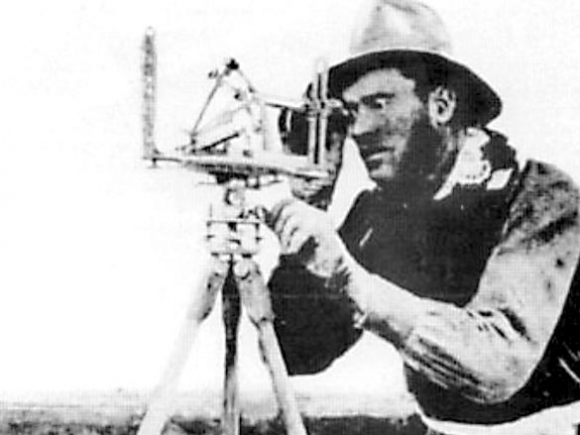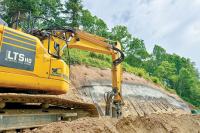Old-time surveyors used some interesting tools, markers

“The line runs down the meander of the ridge to where Bossy dropped her first calf.”
“The line runs to where a block of ice stood in the road.”
“Proceed for about the distance it takes to smoke two cigarettes.”
Through the years, my wife and I have located tree slashes, stones, stakes, etc., which delineate the boundaries of the cove in which we live. Right off the bat we discovered that old-time Appalachian surveys and deeds can be confusing and informational and amusing at the same time.
The oldest specific deed I’ve found in the Swain County records for our cove dates to January 1904: “On the Waters of Lands Creek. BEGINNING on a beech in the Matthew Garrett line and runs S. 65 W. 79 poles to a pine on top of a ridge between Lands Creek and Tuckaseegee River; then up the ridge as it meanders N. 4 W. 10 poles to a hickory . . . then down the ridge as it meanders S. 9 W. 29 poles to a black oak . . . then S.W. 4 poles to a buckeye and spruce pine on the creek; thence to the BEGINNING, containing 35 acres more or less.”
I’m not sure what a “spruce pine” is in this context. At 1,700 feet, the elevation is too low for red spruce. And the cedar pine, which is sometimes called “spruce pine,” is found in the coastal plain and piedmont. My “guess” is that the reference is to short-leaf pine.
Related Items
A second 10-acre tract (“more or less”) was added to the property in 1910. By that time, the beech at the “BEGINNING” of the 1904 tract had either died or, more likely, been chopped down for firewood. The first line of the subsequent deed was emended to read: “BEGINNING at a white walnut tree … go S 67 W 47 poles to a pine on the top of the ridge between Lands creek and Tuckaseegie River.” The white (or butternut) walnut has disappeared, no doubt a victim of the butternut canker blight that entered the southern mountains in the latter part of the 20th century.
Other factors contributing to the poor quality of land descriptions included a lack of slope corrections in early surveys, missing reference points, local names for tree species and the sloppy quality of hand-copied deeds, all of which make things difficult if not impossible for the surveyor.”
Several years back, I found and printed out an online essay by Tennessee surveyor Phillip Meeks titled “Appalachian Surveying.” The essay is no longer posted, but I still have notes from the hardcopy. Under the heading “Natural Obstacles,” Meeks noted that “what these mountains lack in height they compensate for in blackberry brambles and thickets of rhododendron. This kind of terrain puts obvious demands on a land surveyor who must constantly deal with slope corrections, slow travel through unforgiving vegetation and dense canopies that render GPS useless: ‘The Good Lord made plenty of flat land [here] but he put it all on its edge.’”
Difficult terrain and crude instruments no doubt resulted in less than ideal land descriptions by early surveyors. In surveying a “pole” equals 16.5 feet (a rod). A local surveyor advised me that sapling poles of that length were used. Rope — being more flexible and lighter — also made excellent “poles.” Where the line extended along a straight course, poles or ropes of 33 or even 66 feet could be employed to save time and energy. A staff-mounted or hand-held compass allowed the surveyor to enter appropriate boundary descriptions in his data book.
The Gunther’s Chain method was also used in old-time surveying for distance measurements. As I understand it, a magnetic compass was set on a tripod and leveled horizontally via the level bubble so as to obtain the direction by bearings. The chain is divided into 100 links, marked off into groups of 10 by brass rings which simplify intermediate measurement.
“Back then,” the local surveyor noted, “surveys using poles, compasses, and Gunther’s Chains were not always perfectly accurate, of course. But we have been able to find one corner and then use old-time pole and compass methods to locate another corner. An old-time survey of 500,000 feet can sometimes be accurate to within 25 or 30 feet.”
(George Ellison is a naturalist and writer. He can be reached at This email address is being protected from spambots. You need JavaScript enabled to view it..)









